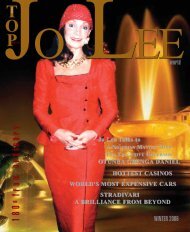WITS END - JO LEE Magazine
WITS END - JO LEE Magazine
WITS END - JO LEE Magazine
Create successful ePaper yourself
Turn your PDF publications into a flip-book with our unique Google optimized e-Paper software.
During World War II the United States,<br />
with Great Britain as the only invited<br />
guest participant, designed, instituted<br />
and implemented the greatest industrial<br />
research and development project in the<br />
history of mankind. With no limitations<br />
whatsoever on its budget, demand for<br />
energy, or on its draw of strategic {for<br />
the war effort} raw materials, the<br />
project’s goal was to develop and<br />
implement a way to manufacture in<br />
quantity two isotopes of elements that<br />
were then considered rare and exotic.<br />
One of these isotopes, Uranium 235,<br />
existed in nature as 0.7% of natural<br />
uranium. The other, plutonium 233, did<br />
not exist in nature, but had been<br />
discovered only at the very beginning<br />
of the time period that the Manhattan<br />
Project came into existence.<br />
The impetus for the Manhattan Project<br />
was simple. The two western leaders<br />
were convinced that if they didn’t<br />
commit to the project and their enemies<br />
did, then if the project were successful<br />
the enemies would win the war by the<br />
threat of or actual annihilation of<br />
America and Britain and any and all of<br />
their allies.<br />
Before you invest in fuel cell<br />
development or any part of the<br />
development of a hydrogen economy to<br />
replace the one we currently have - ask<br />
yourself what is the driving force<br />
behind such a change?<br />
The original impetus for a switch from<br />
fossil fuels to ‘hydrogen’ was the<br />
reduction of pollution deemed injurious<br />
to health and habitat.<br />
Engineering a fuel cell based electric<br />
power generating system to power a<br />
vehicle has not proved as simple as<br />
designing and building an atomic<br />
weapon.<br />
All fuel cells are based on the<br />
discovery, more than a century ago, that<br />
platinum group metals can catalyze<br />
chemical reactions. This means that<br />
they can participate in a chemical<br />
reaction without themselves being<br />
changed, so they are not used up.<br />
Gasoline, for example, is produced by<br />
the catalytic cracking, using platinum<br />
group metals, of long chain<br />
hydrocarbons in crude oil to produce<br />
the short chain more easily combusted<br />
mixtures known as gasoline.<br />
Also to be taken into account are<br />
engineering issues long resolved in<br />
contemporary internal combustion by<br />
gasoline driven cars, such as the effect<br />
on dynamic mechanical components of<br />
turning sharply. In contemporary cars<br />
where engine power is delivered<br />
through transmission connection to a<br />
drive shaft, a differential gear box<br />
distributes power so that axles don’t<br />
bend or break from differential stress<br />
when the car is turning. On an electric<br />
fuel cell powered car with individual<br />
motors driving each wheel, a different<br />
arrangement is needed. This and other<br />
historical already solved problems must<br />
be solved again and so on.<br />
The key to understanding this is to<br />
recognize that contemporary<br />
automobiles are powered by safe,<br />
reliable, efficient engines the main<br />
drawback of which is not mechanical -<br />
it is environmental. This is a political<br />
issue, and it is requiring that the laws of<br />
physics and the properties of materials<br />
be tailored to meet a political goal.<br />
The methods used for the mass<br />
production of energy have been dictated<br />
globally up until now solely by cost, not<br />
politics.<br />
Both Korea and Japan have now active<br />
government sponsored strategic metals<br />
stockpile programs that will allow the<br />
financial departments of their large<br />
electronics manufacturers to remain<br />
calm as prices, and real and artificial<br />
shortages, for the necessary raw<br />
materials for fuel cell manufacturing<br />
defeat American and European<br />
electrical and electronic component<br />
manufacturers. China has already<br />
demonstrated its plan to control its<br />
natural resources as well as any outside<br />
of China on which it can get its hands.<br />
If China should develop or acquire the<br />
technology to mass produce fuel cells<br />
then its domestic range of raw materials<br />
will give it the upper hand, because no<br />
matter which technology predominates,<br />
China will have the deepest and<br />
broadest access to specialty raw<br />
materials.<br />
SUMMER 2007 <strong>JO</strong> <strong>LEE</strong> 45

















